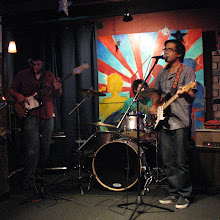Miking for "stereo" for rhythm guitar.
There are several ways to get a "bigger" sound for rhythm guitar. One way is to record the sound source in multiple mono (2 or more tracks of mono signal) which can be panned left or right to create an illusion of space. This is not the same as duplicating a track and panning them to either side, since duplicating creates an exact copy and the sound waves generated by the signal are doing the same thing at the same time, which in effect makes it sound mono.
Anyway, since my guitar cabinet has two speakers, I decided to mike up both speakers with two Shure SM57s at relatively the same points on the speaker. No two speakers are exactly alike, with slightly different frequency responses and sound pressure levels, and this technique yielded a more lush and slightly wider-than-mono sound. However, because both mikes were placed the same distance from the speakers, it wasn't a "mile wide" stereo image when panned right left, which is useful.
Front and back miking of a guitar cabinet.
A little crazier is front and back miking. For the next set of rhythm guitar tracks, I didn't want to have the same sound jumbling up the mix and have each guitar fighting for sonic space, so I decided to use front and back miking. This works particularly well if your amplifier or speaker cabinet is open-backed. The key is to have each microphone placed at relatively the same spot on the speaker cone (for example halfway between the center cone and the edge of the speaker) and about the same distance away from the speaker itself.
Front mic placement. (Grille cloth removed for illustration)
Back mike placement.
It may appear that the front microphone is placed further away than the back microphone, but it isn't. It only appears that way because the front mic is compensating for the depth the speaker cabinet. Please note that I have not ever tried miking the inside of a speaker cabinet, so I'm not sure what kind of sound that yields.
It is also very important to check for phasing when doing this. When listening back, listen for thinness, muddiness or otherwise the guitar amplifier not sounding like it does in the room. Phasing can be used for interesting sounds and effects, but remember that if something doesn't sound right when it is tracked, it would be very difficult if not impossible to remedy the problem later.
Anyway, thanks for reading. I'll be posting sound bites soon!





No comments:
Post a Comment